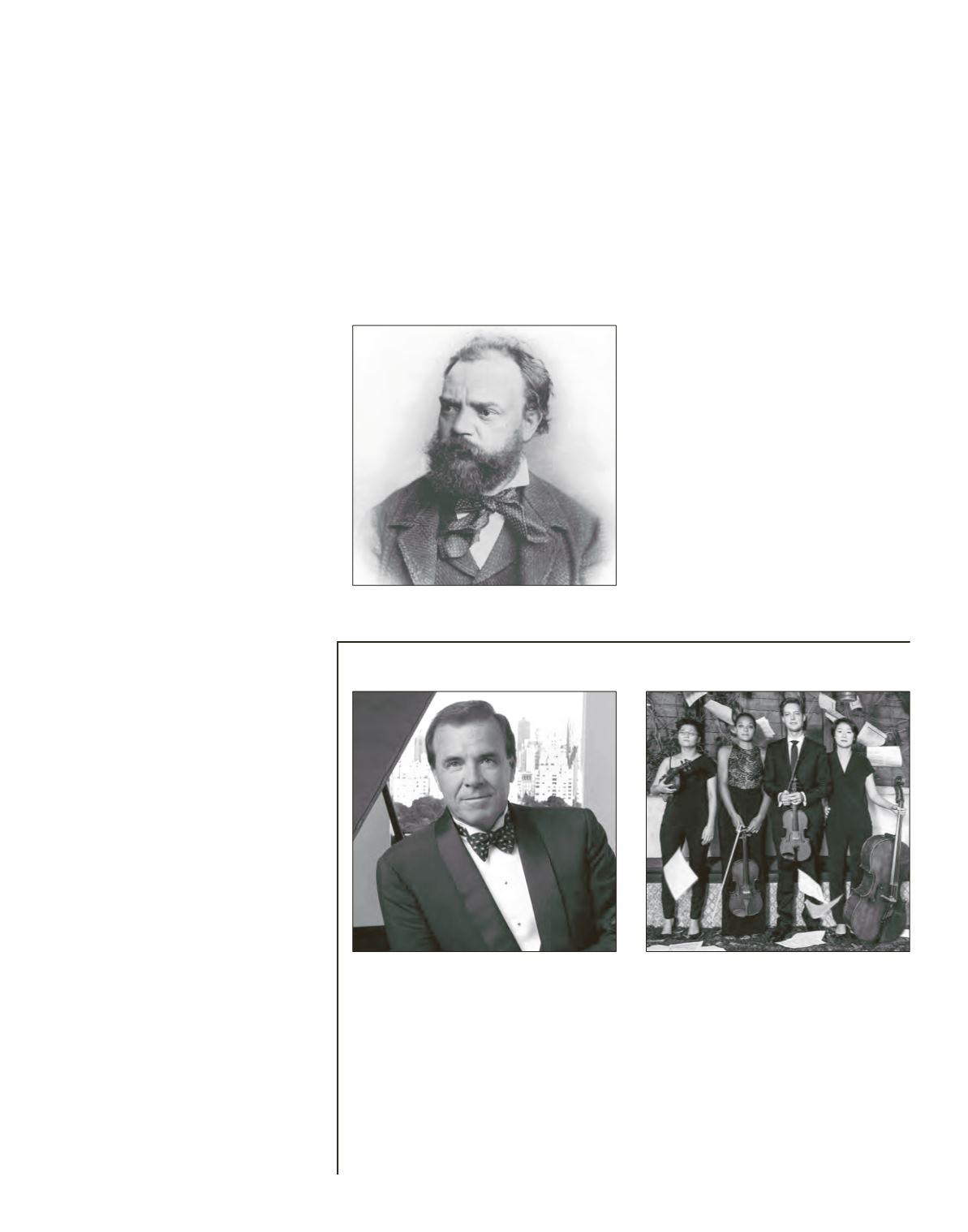

sections: a slow keyboard toccata later joined by
strings, a faster triple-meter theme, and a varied
return of the toccata. Following a brief pause,
the
Fugue
begins with the muted first violin
stating a melancholy six-measure theme; second
violin, cello, viola, and piano follow at irregular
time intervals. Mutes are removed for the nu-
merous contrapuntal elaborations of the theme.
The movement builds to a poignant coda.
The
Scherzo
contrasts the seriousness of the
foregoing movement with an intentionally ba-
nal triple-meter theme filled with melodic and
bass repetitions. A mismatched pair of themes
appears in the
trio
: a gypsy-styled violin melo-
dy followed by the stratospheric dissonances of
a keyboard theme. The
scherzo
music resumes,
now greatly varied.
Shostakovich linked the final two movements.
The
Intermezzo
continues a 19th-century tradi-
tion of light, lyrical middle movements. Musical
passions increase near the end as the ensemble
is segmented into imitating duets (two violins
against viola and cello) and a “basso continuo”
keyboard part. Without interruption, the music
progresses into the
Finale
. The piano introduces
a series of motives that are expanded into sev-
eral themes. Though more casual than many of
the composer’s finales, this movement contains
many standard Shostakovich features, such as
double octaves in the piano and a militaristic
rhythmic pattern first presented by the strings.
One musical moment resulted from an error
during rehearsals, when Rudolph Barshai (vio-
list in the Quartet of the Moscow Philharmon-
ic, later Borodin Quartet) missed an entrance.
The unintentional imitation suited the over-
all neo-Baroque character of the quintet, and
Shostakovich rewrote his score to incorporate
the effect. The Piano Quintet ends quietly and
untroubled.
ANTONÍN DVOŘÁK (1841–1904)
Piano Quintet No. 2 in A major, B. 155
By 1887—the year of his Piano Quintet, B. 155—
Dvořák embodied to the world the musical
soul of the Czech people. His nationalist op-
eras
The Cunning Peasant
,
Dimitrij
,
The Jacobin
,
and
Rusalka
incorporated folk themes that not
only appealed to his countrymen but struck a
sympathetic chord beyond his native land, in
England especially. The instrumental Slavon-
ic Dances published by Simrock undoubtedly
were his most profitable creations. Dvořák’s
strong sense of ethnicity flared only once in his
professional dealings with Fritz Simrock over
the issue of Czech versus German titles on the
printed scores: “An artist too has a fatherland in
which he must also have a firm faith and which
he must love.”
More than nationalism lay behind Dvořák’s
gracious exterior. Czech aloofness and melan-
choly mingled with a tempered gaiety. Profound
introspection predominates over public displays
of exuberance. Dvořák was a more enigmatic
and private figure than any single designation,
“nationalism” or otherwise, could signify. This
complex nature displays itself in the Piano
Quintet in A major, B. 155, which some writers
suspect is an autobiographical portrayal. The
work emerged from the composer’s frustrated
efforts at revising an earlier quintet in the same
key, B. 28. Composition proceeded steadily be-
tween August 18 and October 3, 1887, and the
premiere took place the following January 6 in
Prague with pianist Karel Kovařovic, violinists
Karel Ondříček and Jan Pelikán, violist Petr
Mareš, and cellist Alois Neruda.
MISHA DICHTER,
piano
Misha Dichter’s biography appears on page 100.
ARGUS QUARTET
The Argus Quartet’s biography appears on page 104.
A rippling piano introduction leads to a cel-
lo melody that quickly takes on a melancholy
minor hue. The first violin rises above the ac-
companying ensemble with a high treble line.
A lyrical, minor-key theme emanates from the
viola. The occasionally turbulent development
never reaches an uncontrolled, impassioned
state. Both principal themes returns slightly
transformed. The
Dumka
adopts the soulful
atmosphere of the Slavic folk lament. The vio-
la—Dvořák’s own instrument—presents a som-
ber refrain. The first contrasting section brings a
gentle violin melody and a music-box variation
in the piano. In the middle of the movement, the
dumka
refrain is recast as a
vivace
toccata. Still,
melancholy prevails in the end.
Dvořák subtitled his third movement
Furiant
after a spirited Bohemian folk dance. While the
exhilarating breakneck tempo of the
furiant
is
present, there is little evidence of its character-
istic hemiola rhythm. This piece more closely
reflects the traditional three-part
scherzo
de-
sign with a tranquil
trio
. The style of the
Finale
,
though not its actual material, is derived from
Czech folk music. Repeated pitches and irreg-
ular phrase lengths lend interest to this rondo.
Exciting 16th-note figures lead to a triumphant
conclusion.
–Program notes © 2018 Todd E. Sullivan
Antonín Dvořák
RAVINIA MAGAZINE | JULY 23 – JULY 29, 2018
110









